
Acacia saligna, commonly known by various names including coojong, golden wreath wattle, orange wattle, blue-leafed wattle, Western Australian golden wattle, and, in Africa, Port Jackson willow, is a small tree in the family Fabaceae. Native to Australia, it is widely distributed throughout the south west corner of Western Australia, extending north as far as the Murchison River, and east to Israelite Bay. The Noongar peoples know the tree as Cujong.
Bachelor's buttons is a common name for several plant species:
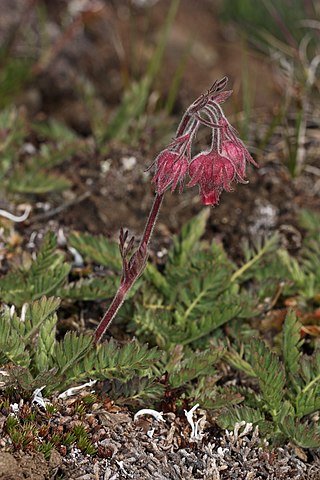
Geum triflorum, commonly known as prairie smoke, old man's whiskers, or three-flowered avens, is a spring-blooming perennial herbaceous plant of the Rosaceae family. It is a hemiboreal continental climate species that is widespread in colder and drier environments of western North America, although it does occur in isolated populations as far east as New York and Ontario. It is particularly known for the long feathery plumes on the seed heads that have inspired many of the regional common names and aid in wind dispersal of its seeds.

Geraea canescens, commonly known as desert sunflower, hairy desert sunflower, or desert gold, is an annual plant in the family Asteraceae. The genus name comes from the Greek geraios, referring to the white hairs on the fruits.

Lithospermum canescens, or the hoary puccoon is a perennial herb endemic to eastern North America. The plant grows in a variety of habitats. It has golden yellow flowers which bloom from April to May.

Blancoa is a monotypic genus of perennial herbs in the family Haemodoraceae; the single species is Blancoa canescens, commonly known as the winter bell. It is endemic to the southwestern corner of Western Australia. It has nodding red to pink flowers, a clumping habit and grows to be 10 to 40 cm in height. The genus is named in honour of Francisco Manuel Blanco, a Spanish friar and botanist who compiled the first comprehensive flora of the Philippines.
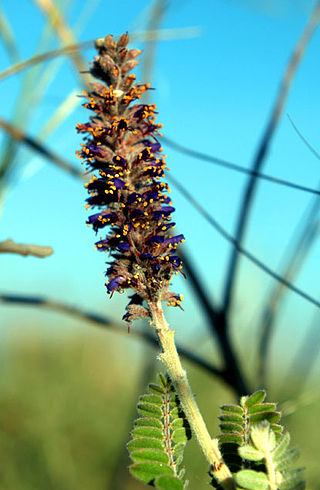
Amorpha canescens, known as leadplant, downy indigo bush, prairie shoestring, or buffalo bellows, is a small, perennial semi-shrub in the pea family (Fabaceae), native to North America. It has very small purple flowers with yellow stamens which are grouped in racemes. Depending on location, the flowers bloom from late June through mid-September. The compound leaves of this plant appear leaden due to their dense hairiness. The roots can grow up to 5 m (16 ft) deep and can spread up to 1 metre radially. This plant can be found growing in well-drained soils of prairies, bluffs, and open woodlands.

Petrophile canescens, commonly known as conesticks, is a species of flowering plant in the family Proteaceae and is endemic to eastern Australia. It is an erect shrub with pinnately-divided leaves and oval heads of hairy, white to pale cream-coloured flowers.
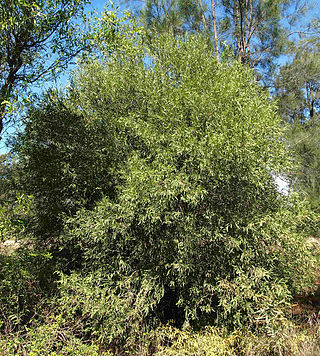
Alectryon oleifolius, commonly known as boonaree, inland rosewood or bullock bush, is a species of small tree of the soapberry family Sapindaceae, native to Australia.

Atriplex nuttallii, also known as Nuttall's saltbush, is native to central and western North America. It has been treated by some botanists as a synonym of Atriplex canescens.
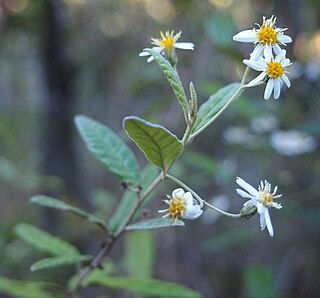
Olearia canescens is a species of flowering plant in the family Asteraceae and is endemic to eastern Australia. It is a shrub with scattered elliptic or egg-shaped leaves, and white and yellow, daisy-like inflorescences.
Terminalia bursarina, commonly known as bendee, is a tree of the family Combretaceae native to northern parts of Australia.
Terminalia canescens, commonly known as joolal, winged nut tree, or wingnut, and also known by its Aboriginal name djilanydjin in north-western Australia, is a tree of the family Combretaceae native to northern parts of Australia.

Cyperus javanicus, also known as the Javanese flatsedge, is a sedge of the family Cyperaceae that is native to Indonesia and Australia.

Scaevola canescens is a species of plant in the family Goodeniaceae. It is endemic to Western Australia where it occurs "from Shark Bay to Perth, in open forest and heath in sandy soil".

Eucalyptus canescens, commonly known as the Ooldea Range mallee or Beadell's mallee, depending on subspecies, is a species of mallee that is endemic to southern Australia. It has rough bark from the base of the trunk to the thicker branches, smooth bark on the thin branches, egg-shaped to lance-shaped adult leaves, flower buds in groups of between seven and eleven, creamy white flowers and smooth cup-shaped to conical, and sometimes ribbed fruit.

Glycine canescens, common name Silky Glycine, is trailing or twining herb. It is a species of soybean native to Australia. A perennial living across the Outback in extremely hot and dry conditions, it is being studied for its potential to improve the cultivated soybean . Grows in sandy or stony soils in a variety of habitats.
Pomaderris clivicola is a species of flowering plant in the family Rhamnaceae and is endemic to a restricted area of Queensland. It is a multi-stemmed shrub with softly-hairy twigs, egg-shaped leaves, and small panicles of yellow to cream-coloured flowers.
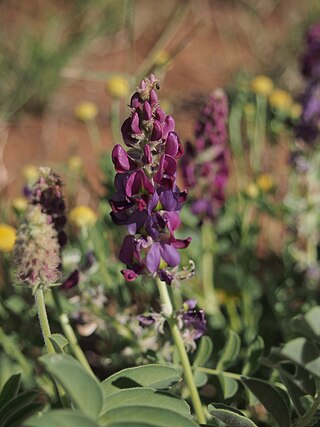
Swainsona canescens, commonly known as grey swainsona, is a flowering plant in the family Fabaceae. It is a small perennial herb with pink-purple or purple, yellow and green flowers and grows in Queensland, Western Australia and South Australia.
Calytrix gomphrenoides is a species of flowering plant in the myrtle family Myrtaceae and is endemic to the Kimberley region of Western Australia. It is a glabrous, multi-stemmed shrub with linear leaves and white flowers turning pink as they age, with 16 to 18 stamens in a single row.















